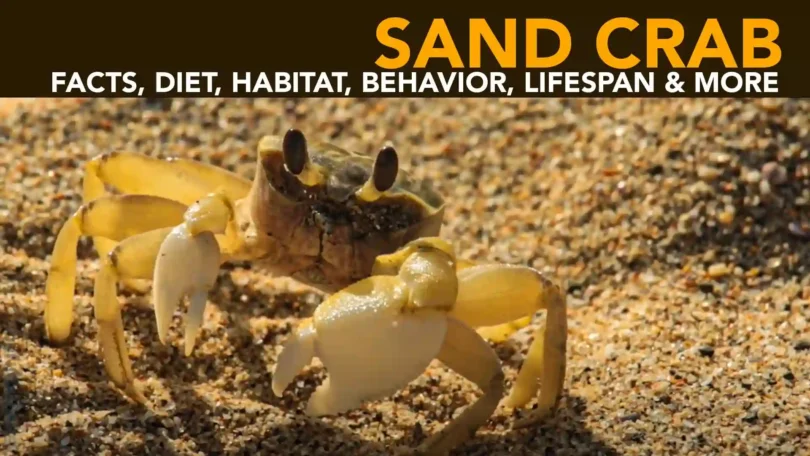Sand Crabs are aggressive creatures who disguise themselves as innocent sandy rocks but attack when approached. They are tiny creatures that are found in abundance around the world and are used for commercial purposes. Here is a fact sheet for sand crabs, which entails all the details about this crab.
Sand Crab – Facts
Scientific name: Emerita analoga
Taxonomic Classification
| Kingdom | Animalia |
| Phylum | Arthropoda |
| Class | Malacostraca |
| Order | Decapoda |
| Family | Hippidae |
| Genus | Emerita |
| Species | analoga |
Physical attributes
Sand crabs are typically little barrel-shaped creatures with a robust domed shell, a sharp tail, pointy legs, and many pairs of antennae. The gray-colored body’s form keeps it balanced and hidden beneath the shifting sands.

Sand Crab
However, unlike so-called “real crabs,” it lacks claws on its first set of legs that allow it to pinch and grab. Sand crabs are not considered to be massive creatures. Males are typically less than an inch long, however, females can grow to be up to 2 inches long. In some species, the male will actually attach himself to the female’s leg.
Habitat
The sand crab can be found on beaches and dunes all over the world, including the African Atlantic coast, both US coasts, the Indo-Pacific region, and Australia. The swash zone is where these creatures reside and feed.

Habitat of Sand Crab
Diet
Sand crabs feed on algae, plankton, mollusks, and dead animals. Sand crabs consume microscopic plankton, mollusks, other smaller crabs, algae, and other organisms. They are referred regarded as scavengers since they rarely eat anything that is not conveniently accessible to them when hiding in their sandy burrows.

Diet of Sand Crab
Reproduction and lifespan
The crab life cycle vary slightly depending on species, although the reproductive season is often in the spring and summer months. Every season, these crabs can produce a massive number of young.
After mating, the female will generate up to 45,000 eggs at once, which she will carry directly on her abdomen. The eggs hatch in about a month and are then abandoned by their parents. As the larvae drift along with the ocean current, they can end up far from their initial birthplace.
The crab life cycle varies widely by species, but the reproductive season is often in the spring and summer months. These crabs can generate a large number of young each season. Following mating, the female will produce up to 45,000 eggs at once, which she will carry on her abdomen.
After about a month, the eggs hatch and are abandoned by their parents. Because the larvae drift with the ocean current, they may finish up far from their birthplace.
Social Behavior
Sand crabs spend most of their time burrowed beneath the sand, with only their eyes and initial antennae exposed. If the crab is disturbed or mistakenly displaced from the sand, it will tread water by thumping its rear legs. They cannot move in any direction but backward, unlike many other crabs.
While there are a large number of these animals on the beach, they are solitary and spend the majority of their time living and foraging alone, except during the reproductive season. The sand crab tail contains the highest known concentration of sensory neurons in the animal kingdom, which is one of the most fascinating facts.

Threats and dangers
Aside from the massive threats provided by their natural predators, sand crabs are most threatened by human disturbances and habitat loss induced by coastal development. This can make it difficult for them to burrow beneath the sand. They are, nonetheless, exceedingly numerous and abundant all across the planet. They are not at risk of becoming extinct.
Conservation status
The data regarding the population count of these species is not known, however, they are in abundance in nature but human activities should have some checks and balances so these crabs aren’t vulnerable anymore.
The Bottom Line
Sand crabs are small barrel-shaped creatures that feed on algae, plankton, and mollusk, and they are found on beaches all over the world. Human activities pose the most threat to their existence, however, they are in abundance till now, but their population can drop in coming years, keeping in view the increased demand for sand crabs to be used as a delicacy.







